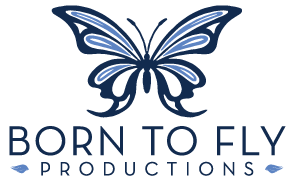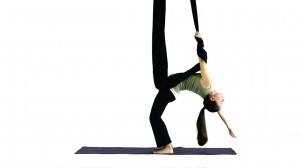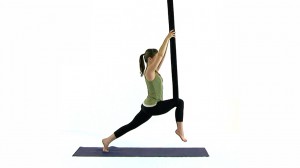I wanted to take a moment to go over a few types of sequence that you can use in your Aerial Yoga Classes. We have been training many teachers lately in the art of aerial yoga, and much of the training tends to focus on individual poses. The first way to further your training is to start building those poses into sequences. That is a whole art in and of itself. And guess what?! This website is here to help you – we have aerial yoga sequences ready for your viewing pleasure, complete with voice-over instruction.We have different types of sequences, and also have sequences from different teachers to give you fresh and different perspectives.
In this blog, I’d like to discuss three specific approaches that are my personal favorites: the Apex Pose Approach, the Ladder Approach, and the Body-Part Target Approach
The APEX Pose Approach
One way to create a sequence for your aerial yoga class is to build it backwards from a specific, challenging pose. For example, camel is no starter pose. Camel requires the hamstrings to be engaged and fully firing. Camel requires the hip flexors to be open (to allow the hamstrings to effectively work), and the core, as well as spine, needs to be warmed up up and ready to operate. So, with this apex (also known as peak) pose in mind, choose moves that will get you there.
In this wheel example, you might start with a general body warm up that could include some cat cow to start warming up the spine. You might start with some light hip flexor openers, then pick a move that engages the hamstrings. This also has the advantage of bringing heat into the body. With that new heat, you can circle back to hip flexor opening, going deeper this time with the blood flowing and heart pumping oxygen to the whole body. In this way, you are warming up the whole body, getting muscles ready to fire, plus focusing on opening the muscles you want open, and engaging the muscles you want engaged for your climatic moment: the Apex Pose (dramatic music here). You should get there around 3/4 of the way into class. After that, it’s all downhill. After that, use the spirally downhill energy of the apex move to get deeper into select stretches, include some gentle counter poses and cool down the body.
For an example of a sequence that is exactly what is described here, log in to your paying account to view our latest supported camel sequence.
The Ladder Approach
I have no idea if “ladder sequence” is an official term or a term that I just made up on the spot. It just seemed to be the right fit. “Ladder Sequence” is the name I give to a sequence that climbs up in progression, each time adding something new. It’s like stepping up to the first rung of the ladder, then stepping down. Then stepping to the second rung, and stepping down. Then stepping to the third rung, and you got the point.
Recently, we uploaded a ladder sequence designed by Amy Tynan into the aerial yoga section of our Video Library. (Login to view!) The sequence revolves around some grounded lunge work and ladder climbs into diaper wrap. The first time you go through the sequence, it stops at the straddle inversion. Then you repeat. The second time adds the crocheted legs. etc. The third time adds a ball crunch, and the fourth time around you complete the ball crunch to pull all the way up into diaper wrap. Each time the sequence is repeated, you switch which leg goes into the crescent lunge, so at the end of the sequence, you have complete two full set of grounded lunge workouts on each leg. (This is an awesome bonus to whole ladder idea.) Each time through the sequence adds other progressions and challenges that can be added as students get more experienced with the sequence. The video in our library shows the full progression through to the end.
The Body-Part Target Approach
I couldn’t think of a better name for this approach, so I called it what it is (I guess). In this approach, you pick specific body parts and focus on those. However, it’s generally good practice to focus on the whole body too. Like every rule, there are exceptions, and there may be days when maybe you do focus on one muscle group for an hour. It’s like getting a massage. It’s nice if the masseuse does a full-body rub down even if the focus is your neck and shoulders. She might spend more time there than at any other body part, but all of relaxation only further helps promote the relaxation of the neck and shoulders. Every once in a while, especially if time is short, she may just simply focus on the neck and shoulders. period. Well, it’s just like that for a yoga class. You could focus on one body part the whole time, or maybe more, or maybe just try to get a little bit of everything. Bonus points for having several sequences pre-planned and then poll the class to see what body part they would like to focus on that day. Maybe it’s the hips that day, or maybe it’s the legs. The other day, I really wanted to focus on bettering my splits for fabric, so I wanted to focus on lengthening/opening my tight legs. Guess what? I also uploaded that video into the library at AerialDancing.com! If you are logged in to your member account, go here to view that sequence.
Well, that’s all folks. Hope this brief lesson on sequences has inspired you to try a new approach to creating an aerial yoga sequence today.
Rebekah Leach is in love with aerial yoga, especially since having two kids and two surgeries. She views aerial yoga as the best way to gradually build the strength and flexibility needed for the other aerial arts. It is also whole and complete for the body as its own thing.


